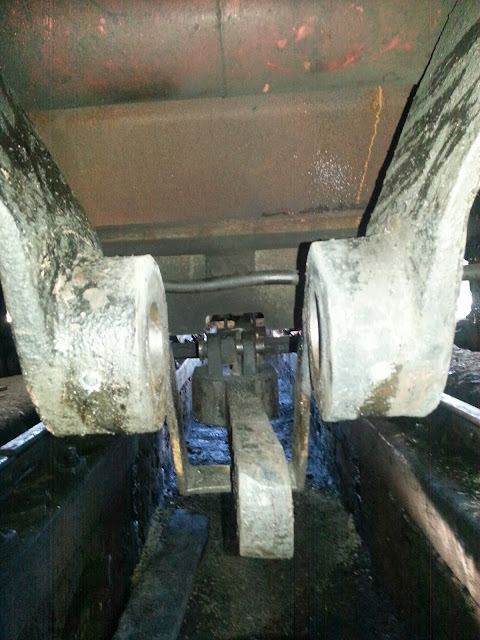Since the last update the loco has been in steam and tests carried out on the overhauled brake and the new boiler blowdown system. Both appear to work well. The Westinghouse carriage warming valve was also tested and appears to work satisfactorily. With the tests complete and the tender tyres looking as if they wont be in the UK before Christmas it was time to drain the boiler and make sure that all the steam piping was free of residual water. We have already had some very cold weather at Aviemore during the last few weeks and its important to take frost precautions.
It's worth saying that the steam brake now makes a significant contribution to stopping the loco - even at relatively low steam pressure. This is something new. In the years that the loco has been operated in preservation the tender brakes have done most of the stopping. It looks like this will have changed considerably when we couple loco and tender together again in 2017...
It's worth saying that the steam brake now makes a significant contribution to stopping the loco - even at relatively low steam pressure. This is something new. In the years that the loco has been operated in preservation the tender brakes have done most of the stopping. It looks like this will have changed considerably when we couple loco and tender together again in 2017...
One job that is being progressed is the refitting of the loco brake crossbeam safety chains. These are intended to protect the loco from potential derailment in event of a brake hanger failure. This is something that must have been a hazard in the 19th Century up until steel manufacturing reached a high level of reliability. One of many interesting features of 828 is that she benefited from the great improvements in materials technology that took place in the 1890s. This meant that where locomotives built only a few years earlier relied heavily on wrought iron and cast iron the 812 Class got the benefit of steel for highly stressed parts. Thus the brake hangers on 828 are steel forgings where a few years earlier they would have been made from less strong wrought iron. This means that the likelihood of a failure is much reduced and so the safety chains became redundant. With time in hand it seems worthwhile refitting them as they are part of the original loco.
I mentioned that the loco had been in steam. This is correct but she was very reluctant to come into steam because the boiler tubes have become sooted up after several steamings without enough exhaust blast to sweep the tubes clean. The consequence of this is that the tubes resist the flow of hot gas and smoke and force it to come out of the firedoor. At the same time the fire burns very sluggishly due to lack of air and the time taken to generate steam increases enormously. The cure is to sweep the tubes with a tube brush - not the most pleasant job with the fire already burning. While I was doing this help came from Alan French who reminded me that a few years ago he had made an 'air amplifier' to stimulate a draft up the chimney of our locomotives as an aid to raising steam. The device was located in the steam store and Alan quickly sorted it out and fitted it. This made all the difference and the fire responded very well indeed. Those familiar with the external blowers fitted to model steam locos for steam raising purposes will be able to picture the principle. The AF Air Amplifier however has no moving parts to go wrong - a marvellous device..!
This will probably be the last post of 2016 so very best wishes to all readers of the Blog and supporters of CR 828 for a very Merry Christmas and a Happy New Year - and let's hope that the Blog changes focus in early 2017 to 828 in operation...!!
This will probably be the last post of 2016 so very best wishes to all readers of the Blog and supporters of CR 828 for a very Merry Christmas and a Happy New Year - and let's hope that the Blog changes focus in early 2017 to 828 in operation...!!
 |
| A view of the cab showing the boiler blowdown pipe sweeping round the firedoor flameplate and disappearing under the cab to enter the ashpan.. |
 |
| Outside Aviemore Shed, a rather sulky 828 making it difficult to raise steam.. |
 |
| At last, the fire getting some air and starting to burn properly.. |
 |
| Two engines in steam in the early winter darkness.. |
 |
| All testing complete and the boiler cooled down - time to drain it down... |
 |
| Boiler Empty......just in case...! |
 |
| One of the two remaining lengths of brake crossbeam safety chain. The crossbeam has a 3/4" hole in it to take an eyebolt. The brake hanger and the brake block are both clearly visible. |
 |
| 117 years of wear - this is what happens when a hard chain link bears against a soft anchor link for more than a century.. |
 |
| Likewise the chain wears on itself over a long time... |
 |
| Cutting 1/2" plate for new anchor links with the slowest mechanical hacksaw in captivity...but it's still easier than sawing it by hand..! |
 |
| Making up the new anchor links that bolt to the loco frame plates.. |
 |
| Eyebolt in place with new anchor link attached to frames and new chain getting measured.. |
 |
| Picture taken for a modeller who requested detail of the lettering on the tender |
 |
| Ditto as above...the correct font and shading as used by the Caledonian Railway Company.. |










































